You are using an out of date browser. It may not display this or other websites correctly.
You should upgrade or use an alternative browser.
You should upgrade or use an alternative browser.
How Racetech Gold Valves work
- Thread starter 900gc
- Start date

Help Support Yamaha FJR Motorcycle Forum:
This site may earn a commission from merchant affiliate
links, including eBay, Amazon, and others.
garyahouse
newbs need the forum
Thanks for posting. Interesting stuff.
Gary
Gary
Interesting video. Thanks for the link.
Just so everyone is clear about this though, the FJR has cartridge forks, so there is no need for "cartridge emulators" for our bikes.
Here's a set of stock valves from the FJR cartridge arranged in the orientation they are normally found installed inside the cartridge tube.
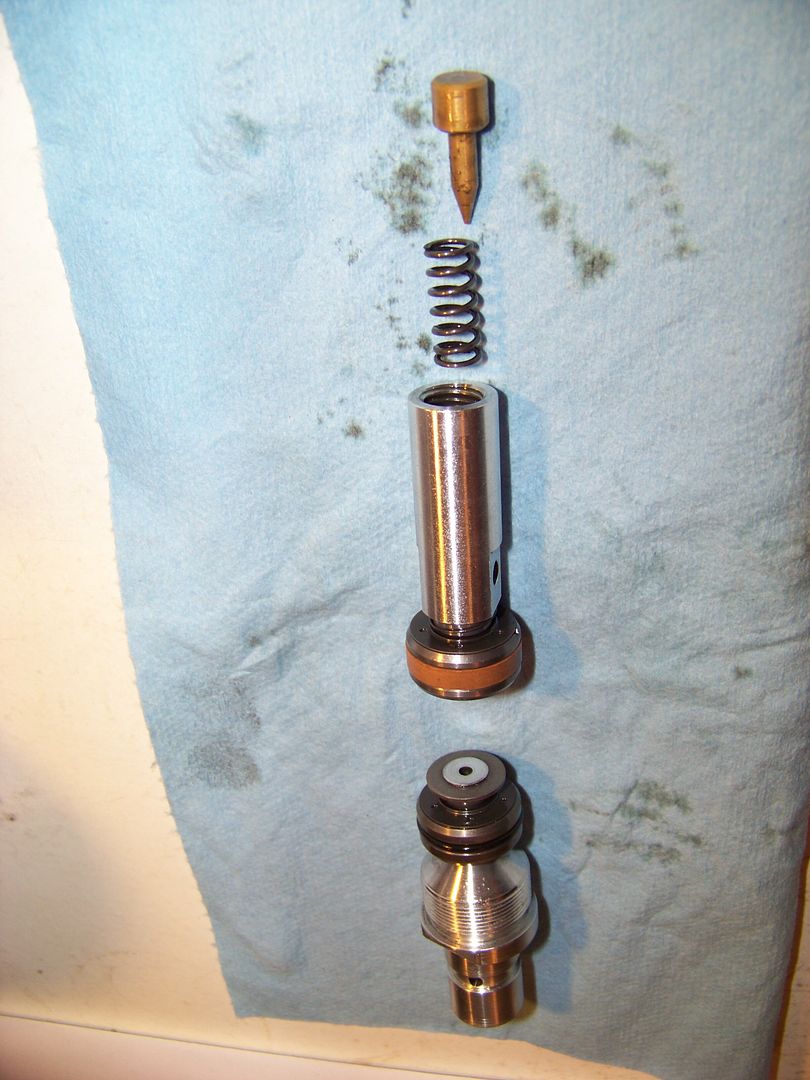
The lower valve is screwed into the bottom end of the cartridge tube and it is responsible for the compression damping. The smaller diameter valve above it is screwed onto the center damper rod and that valve is responsible for rebound damping. The brass needle and spring fit inside of the rebound valve. That is what is at the other end of that skinny little rod that runs down through the hollow damper rod and is how the clicker on the top of the fork adjusts rebound damping.
If you look at these closeups you can see that the stock valves each have a spring loaded check valve plate that affects the other valve's action. The check valve on the compression valve is open during rebound and vice versa.
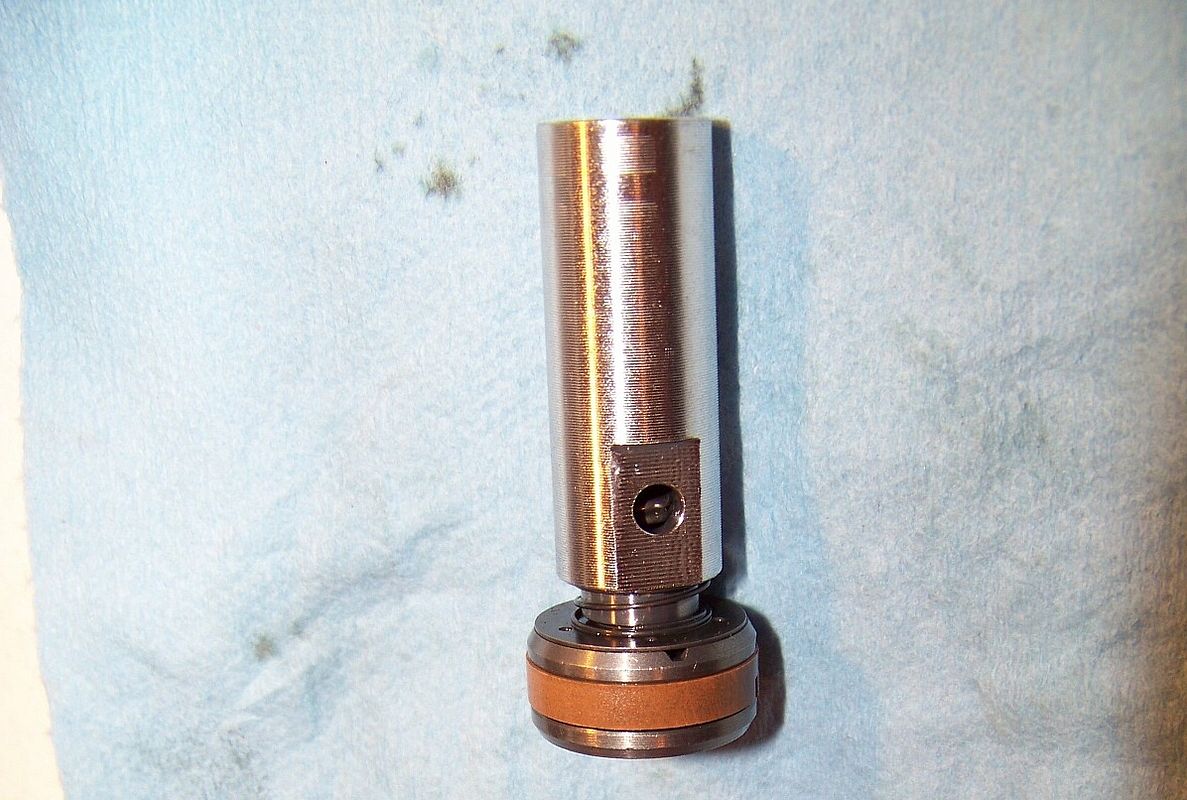
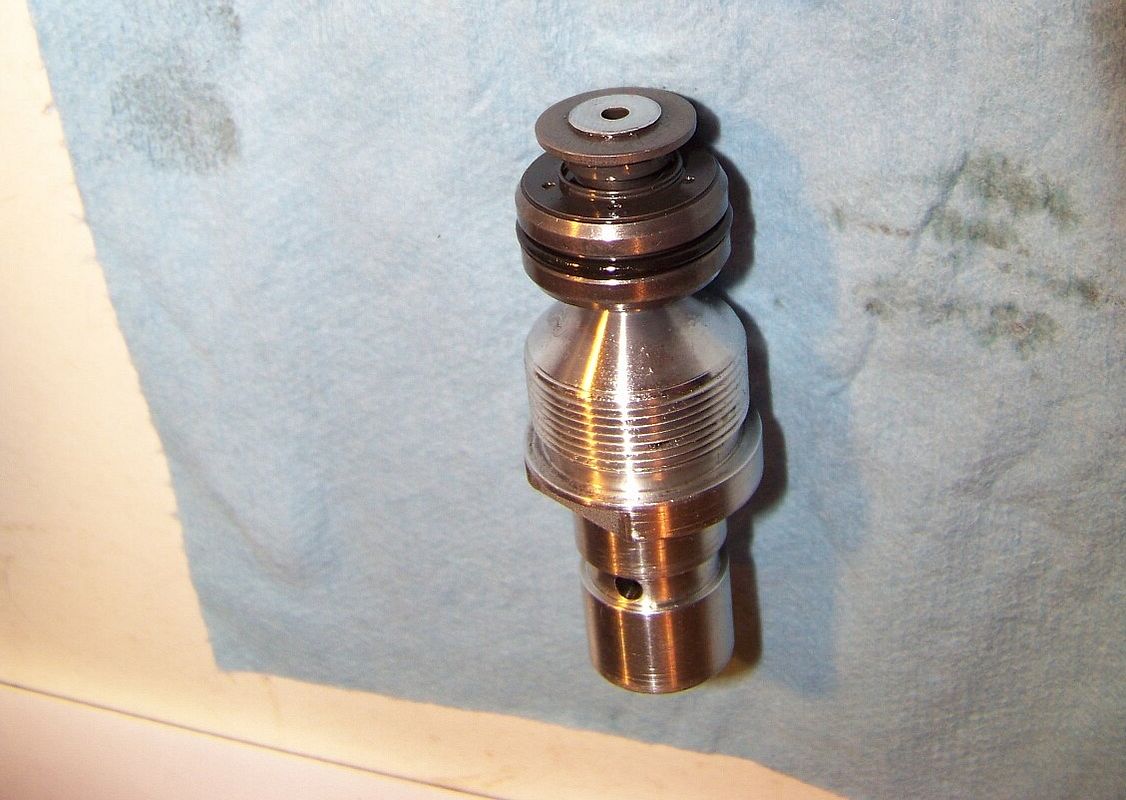
Those springs are very soft and intended to just open freely in the one direction and block off flow in the other. So all of the "tuning" is in the size of the holes under those check valves, the holes running through the middles of the valves, and the adjusters which also block more or less flow.
Just so everyone is clear about this though, the FJR has cartridge forks, so there is no need for "cartridge emulators" for our bikes.
Here's a set of stock valves from the FJR cartridge arranged in the orientation they are normally found installed inside the cartridge tube.

The lower valve is screwed into the bottom end of the cartridge tube and it is responsible for the compression damping. The smaller diameter valve above it is screwed onto the center damper rod and that valve is responsible for rebound damping. The brass needle and spring fit inside of the rebound valve. That is what is at the other end of that skinny little rod that runs down through the hollow damper rod and is how the clicker on the top of the fork adjusts rebound damping.
If you look at these closeups you can see that the stock valves each have a spring loaded check valve plate that affects the other valve's action. The check valve on the compression valve is open during rebound and vice versa.


Those springs are very soft and intended to just open freely in the one direction and block off flow in the other. So all of the "tuning" is in the size of the holes under those check valves, the holes running through the middles of the valves, and the adjusters which also block more or less flow.
How does the compression adjustment valve accessed on the outside of the lower fork affect the compression device shown above? Are there two compression valves in series -- the one shown above and the other built into the lower fork?
Here's how it appears to work:
The hole in the center of the valve is the only path for oil flow inside the cartridge to get out during compression. It goes all the way through the valve body. Here's a look at the other end of the valve:
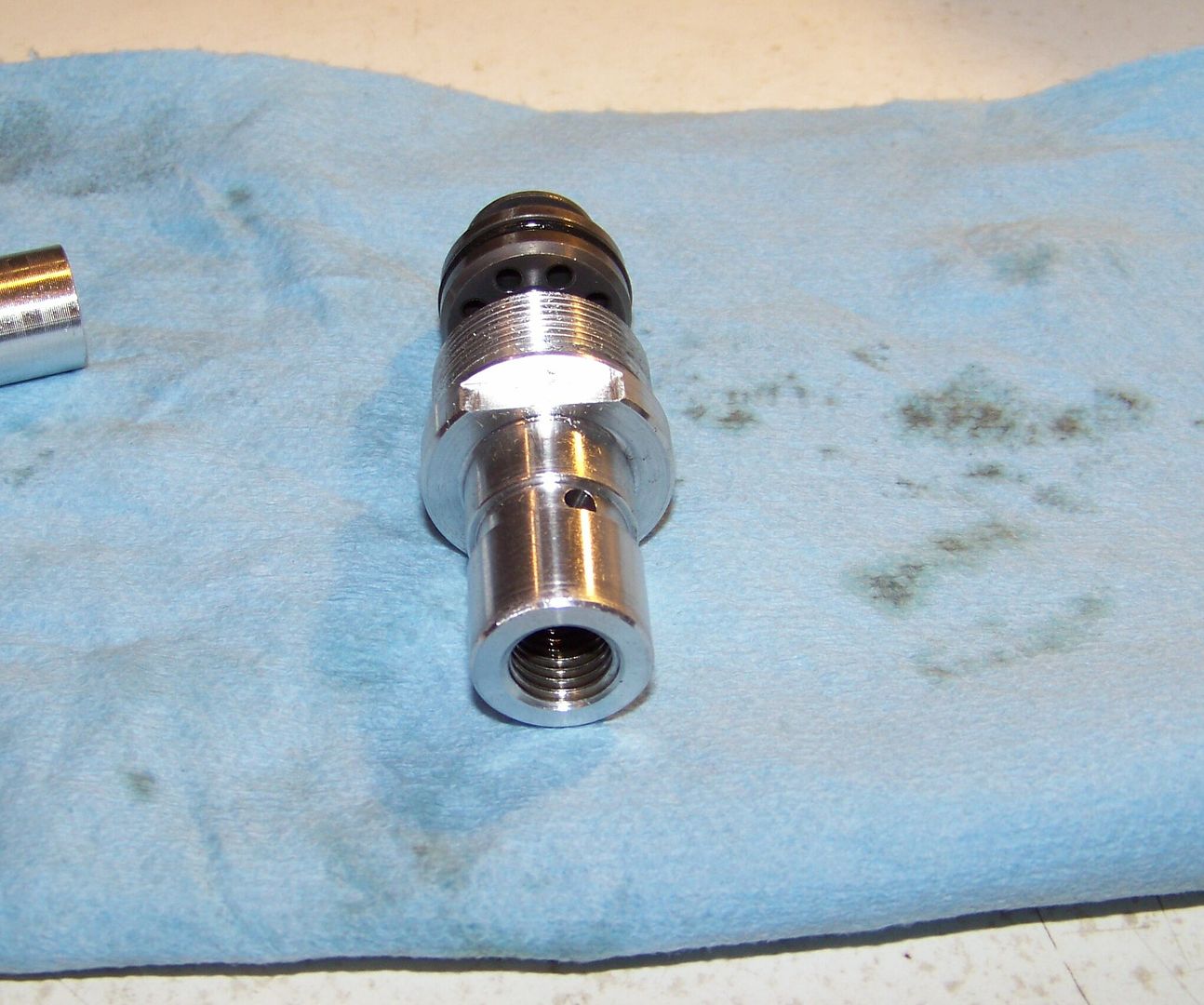
These internal threads at the bottom end is where the socket head cap screw goes in from outside the bottom of the outer fork tube to hold the cartridge to the lower tube and has an alloy sealing washer on the outside (part #12,35 13,36), so that plugs up the bottom of the valve. So the oil getting forced down through the center hole and has to exit through the side hole you see in the above picture.
The whole bottom of the valve is nested inside the tapered spindle (part # 11,34), which fits closely inside the lower leg bottom. The only real open passageway back upwatd to the fluid in the lower leg is a small cavity in the side where the working end of the clicker adjuster is. The adjuster just block off more or less of the oil flow from escaping from between the spindle and lower fork leg.
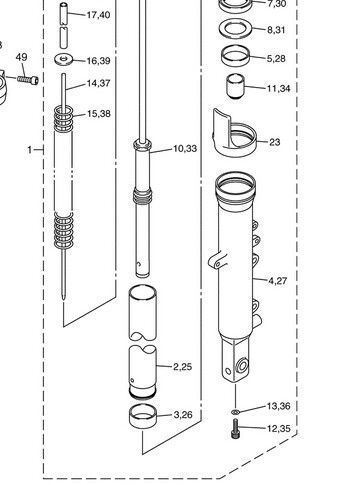
The big holes in the lower part of the cartridge (10,33) fall between the large outside threads and the o-ring sealed check valve on the compression valve, and that is the path that the new oil is drawn into the cartridge during rebound.
The hole in the center of the valve is the only path for oil flow inside the cartridge to get out during compression. It goes all the way through the valve body. Here's a look at the other end of the valve:

These internal threads at the bottom end is where the socket head cap screw goes in from outside the bottom of the outer fork tube to hold the cartridge to the lower tube and has an alloy sealing washer on the outside (part #12,35 13,36), so that plugs up the bottom of the valve. So the oil getting forced down through the center hole and has to exit through the side hole you see in the above picture.
The whole bottom of the valve is nested inside the tapered spindle (part # 11,34), which fits closely inside the lower leg bottom. The only real open passageway back upwatd to the fluid in the lower leg is a small cavity in the side where the working end of the clicker adjuster is. The adjuster just block off more or less of the oil flow from escaping from between the spindle and lower fork leg.

The big holes in the lower part of the cartridge (10,33) fall between the large outside threads and the o-ring sealed check valve on the compression valve, and that is the path that the new oil is drawn into the cartridge during rebound.

$46.95
Harley Davidson Logo Sport Duffel (Tail of The Dragon), Black, One Size
Wisconsin Harley-Davidson

$44.99
Real Time Industries Reflective Decals for Yamaha FJR1300 Gen 2 Fairing (Black - Silver Print)
Real Time Industries

$127.99
$159.99
FLAVOR Men Brown Leather Motorcycle Jacket with Removable Hood (Large (US standard), Brown)
FLAVOR Leather

$49.00
WILD HEART Waterproof Motorcycle Duffel Bag PVC500D With Rope Straps and Inner Pocket 40L 66L 100L for Kayaking, Camping, Boating,Motorcycle
ZHONGSHAN WILD FRUIT OUTDOOR

$22.09
$25.99
MOREOK Waterproof & Windproof -30°F Winter Gloves for Men/Women, 3M Thinsulate Thermal Gloves Touch Screen Warm Gloves for Skiing,Cycling,Motorcycle,Running-Black-XL
MOREOK-US (Ships from USA)

$24.37
Fuel Tank Sticker Motorcycle Stickers for Yam&aha FJR1300 FJR 1300 Tank Pad Protector Decal Emblem Side Fairing Symbol Adventure
nanyangshixianpushangmaohanggerenduzi

$64.99
Edwards Oil Change Kit fits 2003-2020 Yamaha FJR1300 Sport Touring
Edwards Motorsports & RV's

$22.09
$25.99
MOREOK Waterproof & Windproof -30°F Winter Gloves for Men/Women, 3M Thinsulate Thermal Gloves Touch Screen Warm Gloves for Skiing,Cycling,Motorcycle,Running-Black-L
MOREOK-US (Ships from USA)

$49.99
$54.99
HOOD CREW Men’s Casual Stand Collar PU Faux Leather Zip-Up Motorcycle Bomber Jacket With a Removable Hood
Jamickiki

$15.15
$21.95
Tough Headwear Balaclava Ski Mask - Winter Face Mask for Men & Women - Cold Weather Gear for Skiing, Snowboarding & Motorcycle Riding (Black)
Tough Outfitters
Thanks for enlightening further Fred. I know that the "Gold Valve" nomenclature can apply to both damping rod and cartridge forks. I just found it interesting that he came up with a pretty neat way to help damping rod forks perform more like our cartridge forks and that cartridge forks can be improved upon with better valving as well.
Yeah, it is pretty confusing, which was why I chimed in.
Considering how simple the stock cartridge's valves are, and that they are essentially non-adjustable (other than the clickers), you can imagine that replacing them with a set of aftermarket valves would be a good thing.
Seeing how their little spring loaded affair works was pretty interesting. They probably have some of them to retrofit into the FJR cartridges.
Considering how simple the stock cartridge's valves are, and that they are essentially non-adjustable (other than the clickers), you can imagine that replacing them with a set of aftermarket valves would be a good thing.
Seeing how their little spring loaded affair works was pretty interesting. They probably have some of them to retrofit into the FJR cartridges.
Last edited by a moderator:
Jack D
Well-known member
I am not a suspension expert but I have "tuned" a few cartridge type front forks by changing the shim stack. I have wondered just what the FJR's front compression adjustment did as most cartridge fork adjusters only affect the low speed damping and are located at the bottom of the fork where they change the diameter of the low speed passage orifice, i.e. the easy bumps. Bigger bumps which would overwhelm the low speed orifice are handled by the shim stack which is what makes the cartridge forks better than damper rod forks. I intended to research this when I put new bushings in the forks. Unfortunately I was lending my bike out to some Australian friends and found the fork seals leaking badly the day before they arrived. So I rebuilt the forks without dismantling the "cartridge". and investigating the valves. While I am happy to see these pictures I am very disappointed in what they show. Unless there are parts that I cannot see these are cartridge forks in the sense that they do have a cartridge but the valves are in essence the same as damper rod forks except they have an external adjustment and that there is a separate valve for rebound and compression while the normal damping rod makes one valve do both functions through the same orifices. Now I am wondering if I will have a low speed compression adjustment if I install RaceTech's Gold Valves. I wonder how the 2014 forks are made.
MCRIDER007
Well-known member
When I examined the spring loaded portion of this valve I was really puzzled as to what it actually did. Since the spring check valve only allows oil to flow in one direction (from the area outside the cartridge into the cartridge chamber between the two valves) it appeared to be part of the rebound circuit but....during the rebound stroke there would not be any pressure on the oil outside the cartridge forcing oil into the cartridge except for a slight vacuum that would be just as strong on both sides of the cartridge. My conclusion was that this is where the air volume adds resistance at the end of the compression stroke, as the air compresses it increases the pressure on the oil outside the cartridge, forcing oil past the check valve into the cartridge and slowing the compression stroke to prevent bottoming.....but this is my theory and even I would not bet on it.Here's how it appears to work:
The hole in the center of the valve is the only path for oil flow inside the cartridge to get out during compression. It goes all the way through the valve body. Here's a look at the other end of the valve:

These internal threads at the bottom end is where the socket head cap screw goes in from outside the bottom of the outer fork tube to hold the cartridge to the lower tube and has an alloy sealing washer on the outside (part #12,35 13,36), so that plugs up the bottom of the valve. So the oil getting forced down through the center hole and has to exit through the side hole you see in the above picture.
The whole bottom of the valve is nested inside the tapered spindle (part # 11,34), which fits closely inside the lower leg bottom. The only real open passageway back upwatd to the fluid in the lower leg is a small cavity in the side where the working end of the clicker adjuster is. The adjuster just block off more or less of the oil flow from escaping from between the spindle and lower fork leg.
The big holes in the lower part of the cartridge (10,33) fall between the large outside threads and the o-ring sealed check valve on the compression valve, and that is the path that the new oil is drawn into the cartridge during rebound.
Jack D
Well-known member
The fork internal volume is at least at atmospheric pressure from being open at assembly time. It will be higher when the oil is heated up and expands. The disc check valves allow oil to flow between the rebound and compression chambers. When the fork is on the compression stroke the check valve opens on the rebound valve allowing oil to quickly flow into the rebound chamber. Some oil also flows through the center hole of the rebound valve. But the compression chamber is moving more oil than can flow into the rebound chamber. The rebound chamber has less volume than the compression because of the displacement of the shaft holding the rebound valve. The difference has to flow through the center of the compression valve and the adjusting valve which also raises the pressure in the fork leg as the extra oil further compresses the air in the fork. On the rebound stroke the the oil is forced through the center of the rebound valve into the compression chamber. The compression chamber is increasing in volume faster than the rebound is shrinking creating a vacuum. The air pressure in the fork pushes oil into the compression chamber through the center hole and check valve. I am assuming that the compression adjuster also has a bypass valve otherwise the valve would restrict oil flow and affect rebound damping. In a conventional cartridge fork the center hole in the valves would be much smaller and the oil would be forced to open the shim stack and let oil flow through the valve plate. The faster the fork travel the more the shim stack would open allowing more oil to flow.
MCRIDER007
Well-known member
The only way the compression chamber can increase in volume faster than the rebound is shrinking is through leakage around the damper rod because otherwise the oil is trapped.....but I would think that an even greater leakage would be around the rebound valve itself. In any case, the vacuum created in the compression chamber would be pretty small because the fork does not move very quickly on the rebound stroke and I'm having a hard time seeing how a very small air vacuum would pull oil through the compression check valve unless there also was a lot of oil pressure on the other side of the check valve....but any oil pressure on that side of the check valve decreases quickly on the rebound stroke and would probably be pretty much gone by the time a air vacuum would be created. If the only reason for that check valve is to allow oil to flow by to fill a small air vacuum then I don't see why a stacked shim is an improvement over a spring valve.On the rebound stroke the the oil is forced through the center of the rebound valve into the compression chamber. The compression chamber is increasing in volume faster than the rebound is shrinking creating a vacuum. The air pressure in the fork pushes oil into the compression chamber through the center hole and check valve. I am assuming that the compression adjuster also has a bypass valve otherwise the valve would restrict oil flow and affect rebound damping. In a conventional cartridge fork the center hole in the valves would be much smaller and the oil would be forced to open the shim stack and let oil flow through the valve plate. The faster the fork travel the more the shim stack would open allowing more oil to flow.
Last edited by a moderator:
FJR Orientation Guide
https://www.fjrforum.com/files/fjr1300guide.pdf
Page 21 includes a cross-section drawing of the fork internals. You can see the external compression adjuster and its location relative to the internals.
A higher quality image of the cross-section would be helpful but I haven't found one.
https://www.fjrforum.com/files/fjr1300guide.pdf
Page 21 includes a cross-section drawing of the fork internals. You can see the external compression adjuster and its location relative to the internals.
A higher quality image of the cross-section would be helpful but I haven't found one.
not2shabby
Well-known member
Hmmm, all this time I've been under the impression that the compression clickers affected the high speed compression too...guess not! I need to get in there and mod my Gold Valve shim stack, it's still got way too much high speed damping. I wonder if removing one of the big shims next to the valve would be enough or if I should take one of the middle smaller ones out too. With my luck, I'll probably have to mod it 2 or 3 times before I get it right!
I guess the rebound is the same way since the holes in the cartridge would handle slow speed rebound, correct?
I guess the rebound is the same way since the holes in the cartridge would handle slow speed rebound, correct?
MCRIDER007
Well-known member
The low speed compression damping circuit works throughout the compression stroke and adds oil flow to the high speed compression circuit....it can also be used to adjust when the high speed circuit "kicks in". This doesn't make much difference to street riding but is pretty important to track riders on low traction corners. I don't have any experience on modifying shim stacks but it would seem that the ratio of large to mid-size to small shims should stay about the same....but a call to race tech might give you the answer if it isn't already buried somewhere in the instructions.Hmmm, all this time I've been under the impression that the compression clickers affected the high speed compression too...guess not! I need to get in there and mod my Gold Valve shim stack, it's still got way too much high speed damping. I wonder if removing one of the big shims next to the valve would be enough or if I should take one of the middle smaller ones out too. With my luck, I'll probably have to mod it 2 or 3 times before I get it right!
I guess the rebound is the same way since the holes in the cartridge would handle slow speed rebound, correct?
The rebound should work the same way as the compression and the rebound shim stack usually is stiffer and flows less oil than the compression shim stack.
not2shabby
Well-known member
That makes sense, the more the low speed circuit flows, the later the shim stack bends. So if I backed off the comp adjuster all the way it should soften up the HS a little in theory...but in reality I can't tell any difference! I suppose thinner oil might help too, but I really think the stack needs to be modded.
I found a web site for 'shimstacker' which is a program used to calculate stacks for different riders/conditions...wow, there were some complex combinations used for examples. Double stacks, stacks with a smaller shim stuck between bigger ones to make it more 'progressive', mid valve stacks, etc. etc. I think a lot of them were for MX bikes. Made my head hurt! All I want to do is tone down my HS compression.
The chart that came with the RT valves lists what shims should be in the stack for soft to hard. I believe I have the C33 stack now.
"https://i1194.photobucket.com/albums/aa370/not2shabby/20131017_153123_zps411b0f6d.jpg"
So it looks like I can take it down several levels.
I found a web site for 'shimstacker' which is a program used to calculate stacks for different riders/conditions...wow, there were some complex combinations used for examples. Double stacks, stacks with a smaller shim stuck between bigger ones to make it more 'progressive', mid valve stacks, etc. etc. I think a lot of them were for MX bikes. Made my head hurt! All I want to do is tone down my HS compression.
The chart that came with the RT valves lists what shims should be in the stack for soft to hard. I believe I have the C33 stack now.
"https://i1194.photobucket.com/albums/aa370/not2shabby/20131017_153123_zps411b0f6d.jpg"
So it looks like I can take it down several levels.
Last edited by a moderator:
Jack D
Well-known member
The difference in volume is due to the displacement of the rod holding the rebound valve. The area of the compression chamber assuming a 20mm bore is pi*20*20/4 = 314 sq. mm. The area of the rebound chamber is the same minus the area of the rod. Assuming that the rod is 8mm in diameter the area will be 314 - pi*8*8/4 (50.24) = 263.76 sq. mm. If the fork moves 20 mm the volume displaced by the compression chamber is 20*314= 6280 cubic mm while the volume displaced by the rebound chamber is 20 * 263.76 = 5275.2 cubic mm, a difference of 1004.8 cubic mm. The oil is not trapped, it is free to flow through the hole in the center of the valve and through the check valve discs but only one at a time. On compression the oil can flow only through the rebound check valve meaning the extra oil has to flow through the center hole of the compression valve. This resistance to this oil flow is the compression damping. On the rebound stroke the oil in the rebound chamber must flow through the center hole of the rebound valve. The resistance to this flow is the rebound damping force. However the volume of the compression chamber is increasing faster than the rebound chamber is decreasing. To keep the cartridge filled with oil the oil from the fork leg flows through the compression check valve making up the difference in displaced volume. The reason that a stacked shim is better than the plate valve is the plate valve in the FJR is a one way valve allowing the chambers to be filled. It has nothing to do with damping. All damping is done through the center hole. This forces the hole to provide damping for both high and low speed fork movement. This forces the designer to compromise. The stacked shim valve is a stack of decreasing diameter shims the largest of which covers a circular array of holes. These holes provide little resistance to oil flow. The resistance is from how much the large diameter shim bends when the oil flowing through the holes forces the large shim to bend. If the force is great enough it forces the large shim to start bending the next shim which allows the large shim to bend more and allow more oil to flow. And so on bending more and more shims in the stack. There is also a center hole in the valve which is used in low fork speed damping. Difficult to follow without pictures, a cutaway view of the internals of a cartridge fork with stacked shim shim valves can be found atThe only way the compression chamber can increase in volume faster than the rebound is shrinking is through leakage around the damper rod because otherwise the oil is trapped.....but I would think that an even greater leakage would be around the rebound valve itself. In any case, the vacuum created in the compression chamber would be pretty small because the fork does not move very quickly on the rebound stroke and I'm having a hard time seeing how a very small air vacuum would pull oil through the compression check valve unless there also was a lot of oil pressure on the other side of the check valve....but any oil pressure on that side of the check valve decreases quickly on the rebound stroke and would probably be pretty much gone by the time a air vacuum would be created. If the only reason for that check valve is to allow oil to flow by to fill a small air vacuum then I don't see why a stacked shim is an improvement over a spring valve.On the rebound stroke the the oil is forced through the center of the rebound valve into the compression chamber. The compression chamber is increasing in volume faster than the rebound is shrinking creating a vacuum. The air pressure in the fork pushes oil into the compression chamber through the center hole and check valve. I am assuming that the compression adjuster also has a bypass valve otherwise the valve would restrict oil flow and affect rebound damping. In a conventional cartridge fork the center hole in the valves would be much smaller and the oil would be forced to open the shim stack and let oil flow through the valve plate. The faster the fork travel the more the shim stack would open allowing more oil to flow.
https://racetech.com/articles/CartridgeForks.htm
A very detailed explanation of this and other suspension theory can be found be found in the excellent book "Race Tech's Motorcycle Suspension Bible" ISBN -13: 978-0-7603-3140-8.
not2shabby
Well-known member
Interesting read there. I think I might experiment with my WR250F first, it has way too much HS compression for a trail bike. It has the stock valves as far as I know, but changing the stack should work on them too. It's a lot easier to get the forks off of it!
Similar threads
- Replies
- 7
- Views
- 782
- Replies
- 2
- Views
- 865




















































